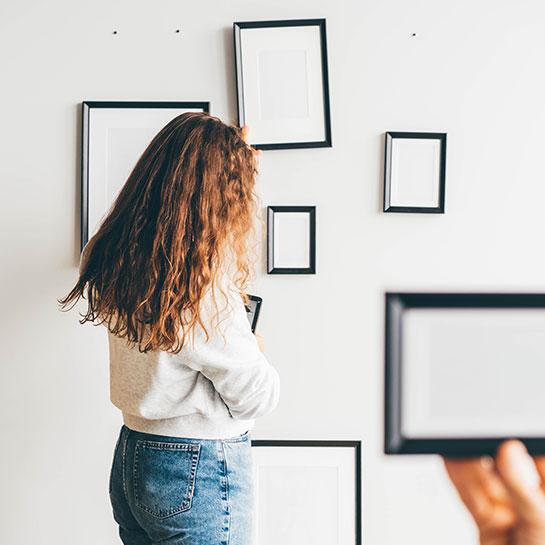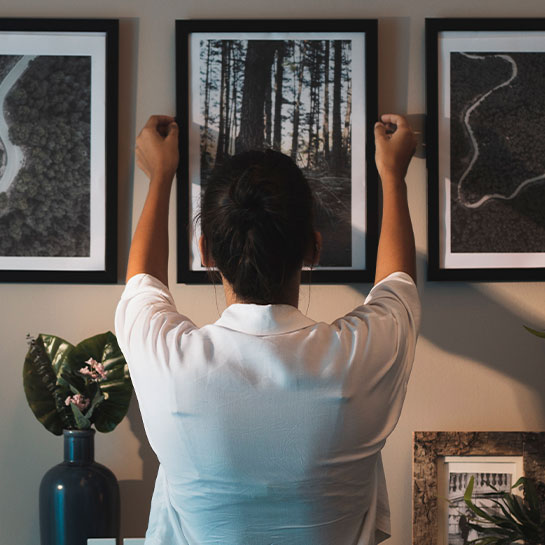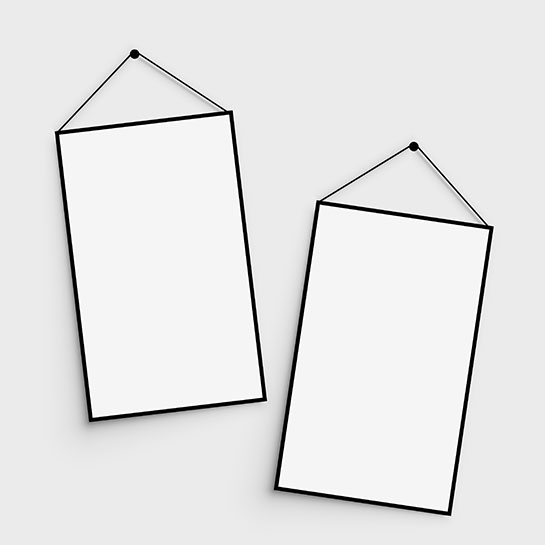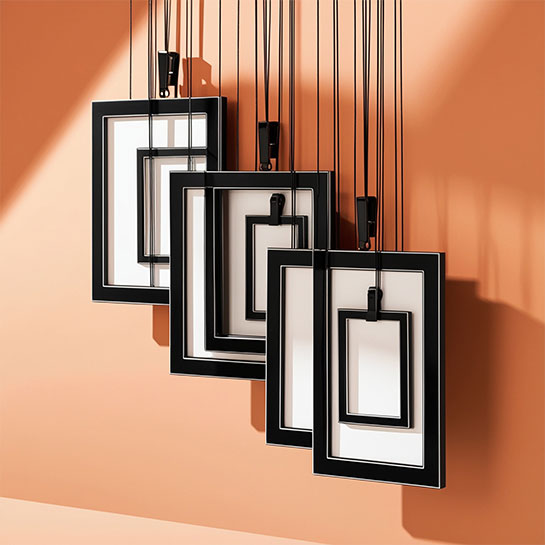Hanging pictures is one of the simplest and most effective ways to decorate the home, bringing style, personality and a special touch to any space. However, making a painting look good depends not only on the art itself, but also on how it is hung. Common mistakes, such as improper height, incorrect proportions or lack of harmony with the furniture, can draw attention away from the overall décor and ruin the effect we’re looking for. In this guide, we will review the most common mistakes when hanging pictures and offer practical solutions so you can hang them like a pro.
Common mistakes when hanging pictures and how to avoid them
Hanging the picture at the wrong height
One of the most common mistakes is to hang pictures too high or too low. This breaks the visual harmony and makes the painting uncomfortable to appreciate, especially in living rooms or hallways where people see it standing up.
Tip: For an ideal height, hang the painting so that the center of the painting is 150-155 cm from the floor, a height that matches eye level for most people. If you are hanging the painting over a piece of furniture, such as a sofa or sideboard, make sure it is about 20-30 cm above the surface of the furniture, maintaining the visual connection between the two elements.

Choosing a painting that is disproportionate to the wall size
A small painting on a large wall often goes unnoticed, while one that is too large on a small wall can overload the space. Proportion is key to maintaining a balanced and harmonious decor.
Tip: On large walls, opt for a large painting that fills the space or, if you prefer small paintings, group them in a composition of several paintings that form a collage. For large paintings, leave at least 20 cm of wall space around the painting, allowing it to “breathe” visually. Before hanging, it is useful to simulate the layout on the floor to get an idea of proportion.
Failure to adjust the distance between frames in a composition
If you are creating a gallery of paintings on the same wall, it is essential to consider the distance between them. Hanging them too close together or too far apart can make the whole look cluttered or scattered.
Tip: When assembling a composition of several pictures, keep a distance of 5 to 7 cm between each frame. This separation allows each frame to have its own prominence without losing the unity of the whole. In the case of large frames, the separation can be extended to 7-10 cm for a more harmonious visual balance.
Hang all pictures in the same shape or in a straight line.
Another common mistake is to hang all the pictures in a straight row or without varying the arrangement, which can make the space look stiff and predictable. While this style is suitable for some places, at home it is ideal to experiment with less conventional combinations.
Tip: Try different layouts, such as squares, diamonds, or interspersing different sizes and frames. Use paper templates to test various configurations on the wall before tacking. You can combine a large picture with smaller ones around it, or create an abstract shape that follows the visual flow of the wall. This will give your space a dynamic and personal touch.

Hanging crooked or unleveled pictures
A crooked painting can make the entire décor look sloppy, even if the art is beautiful. It’s easy for paintings to move, especially on walls near doors or windows that are frequently opened and closed.
Tip: Use a level before hanging to ensure that the picture is perfectly aligned. Adjustable hooks and adhesive hangers are also available to help maintain a straight position. If the frame tends to warp, place small rubber bumpers or adhesive pads on the bottom corners of the frame to prevent it from moving.

Decorating only with pictures and no other elements on the wall
A common mistake when decorating with paintings is to fill all the walls only with them, which can detract from the dynamism of the environment and make it monotonous. Including other elements can give the space more depth and visual complexity.
Tip: Alternate pictures with other decorative objects such as mirrors, clocks or shelves. Mirrors, for example, reflect light and make the space appear larger. Shelves can complement pictures by displaying mementos or small decorative objects. Leaving some areas of the wall empty can also highlight the composition of pictures and give it more prominence.
Tips for proper picture hanging
Use frames of different colors and styles
To give the wall more dynamism, combine frames of different colors, textures and styles. This adds visual interest and allows you to create a unique composition that reflects your personal style.

Avoiding drill holes with non-drilling hanging options
If you prefer not to make holes in the wall, you can place the pictures on shelves or furniture. This option is ideal for those who prefer a flexible and changing decoration. In addition, resting them on furniture or shelves adds a modern and unstructured touch to the space.
The two-thirds rule in paintings
When hanging pictures on a piece of furniture, make sure that the picture (or set of pictures) occupies about two-thirds of the width of the furniture. This rule helps create a balanced proportion and prevents the painting from dominating or getting lost on the wall.
Decorating with paintings can be a simple and fun task if we avoid some of the most common mistakes and apply little tricks that really make a difference. Let’s remember that paintings are not only decorative elements, but also reflect our personality and give life to the walls of the home. By following these tips, you can hang pictures with the confidence that they will look like a true design element, bringing harmony and style to any space.
What is the ideal height for hanging a picture?
The ideal height for hanging a painting is to place its center about 150-155 cm from the floor, which coincides with the level of the eyes. If it is on a piece of furniture, it is recommended that the lower edge is about 20-30 cm from the furniture.
How can I create a balanced composition of pictures on a large wall?
For a large wall, you can create a collage with several small pictures, leaving a distance of 5-7 cm between them. Before hanging, test the design on the floor or use paper templates to visualize the result and adjust the balance.
Is it possible to hang pictures without drilling holes in the wall?
Yes, you can rest the pictures on shelves or furniture, or use special adhesive hangers. This option is ideal for flexible decoration, allowing you to move the paintings without damaging the wall.


